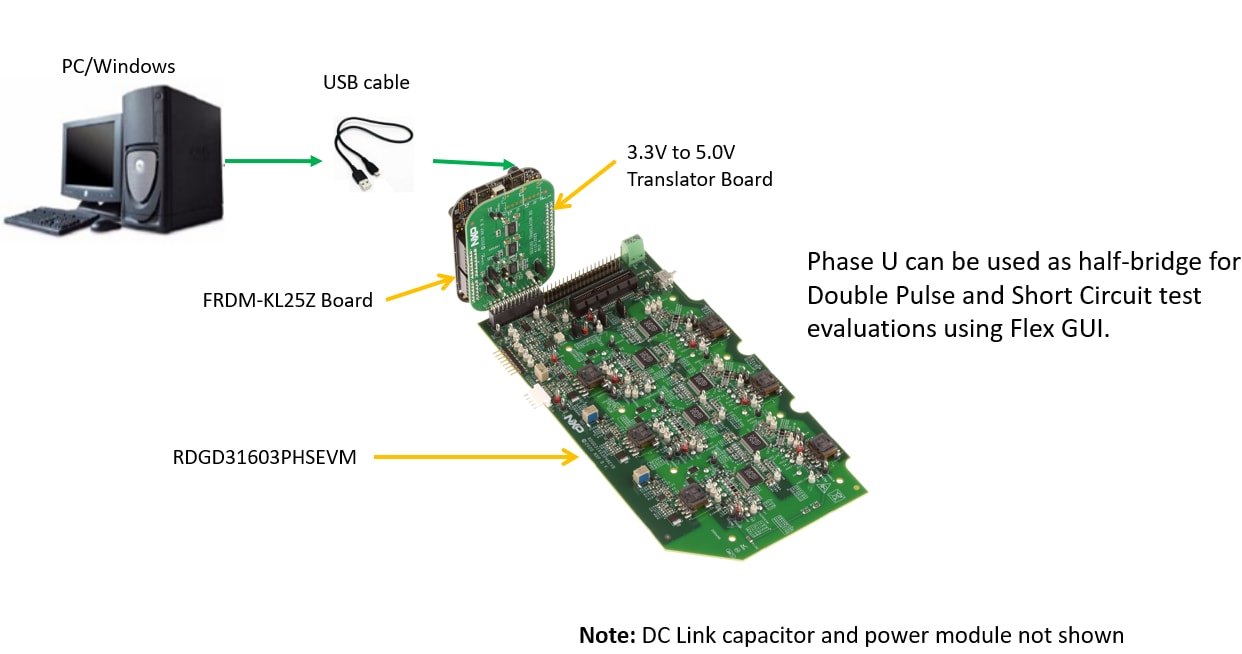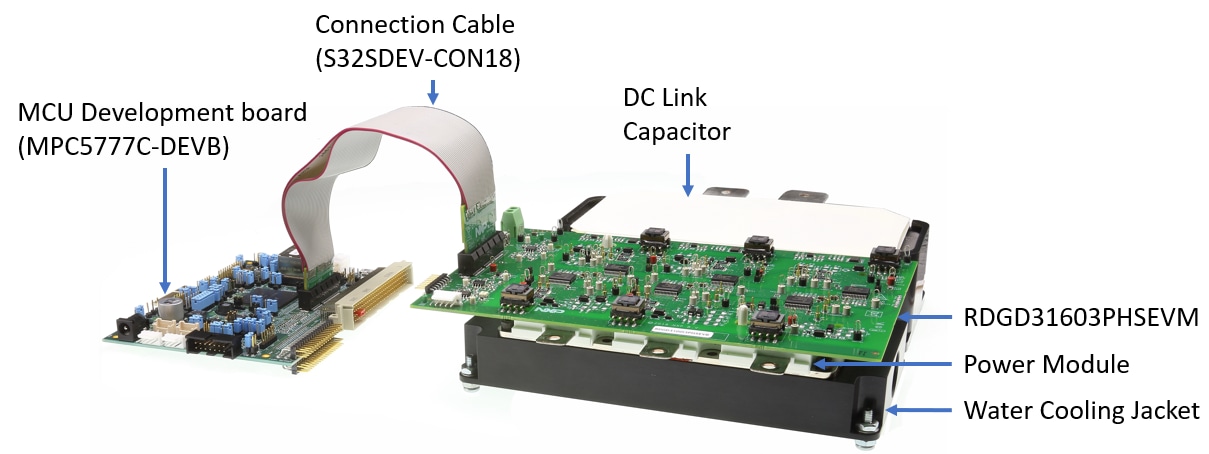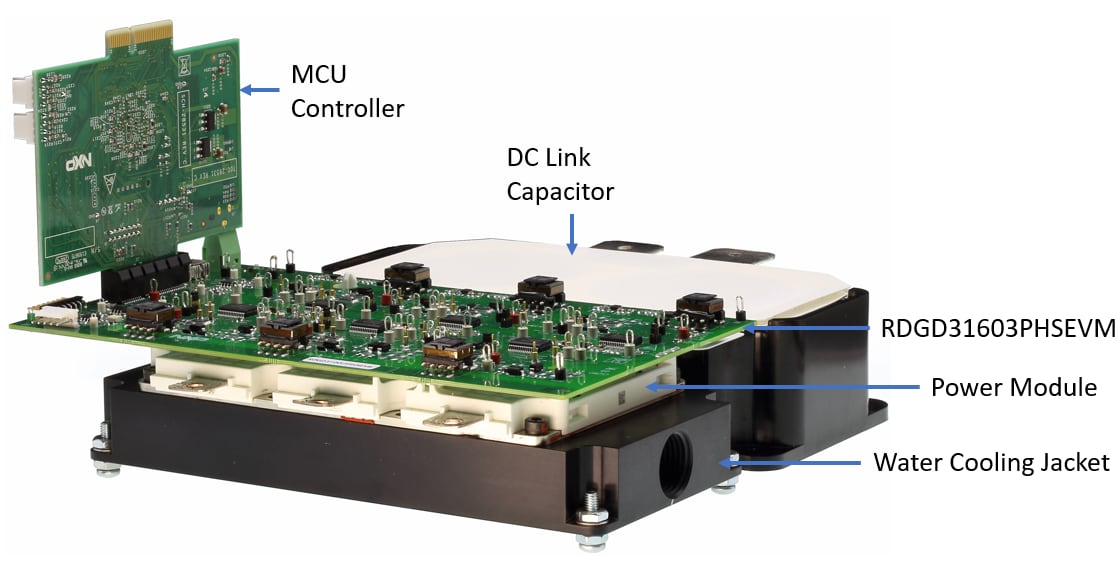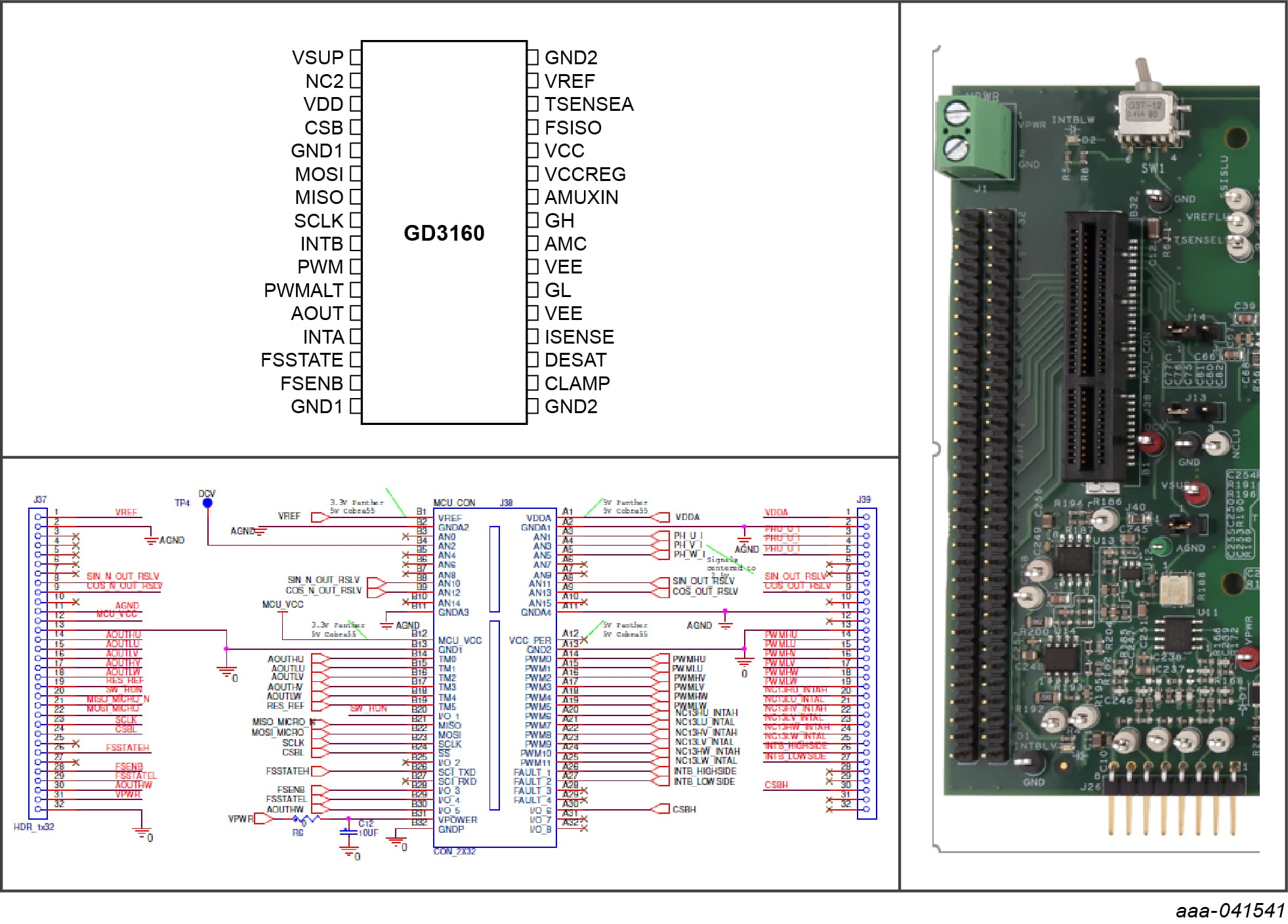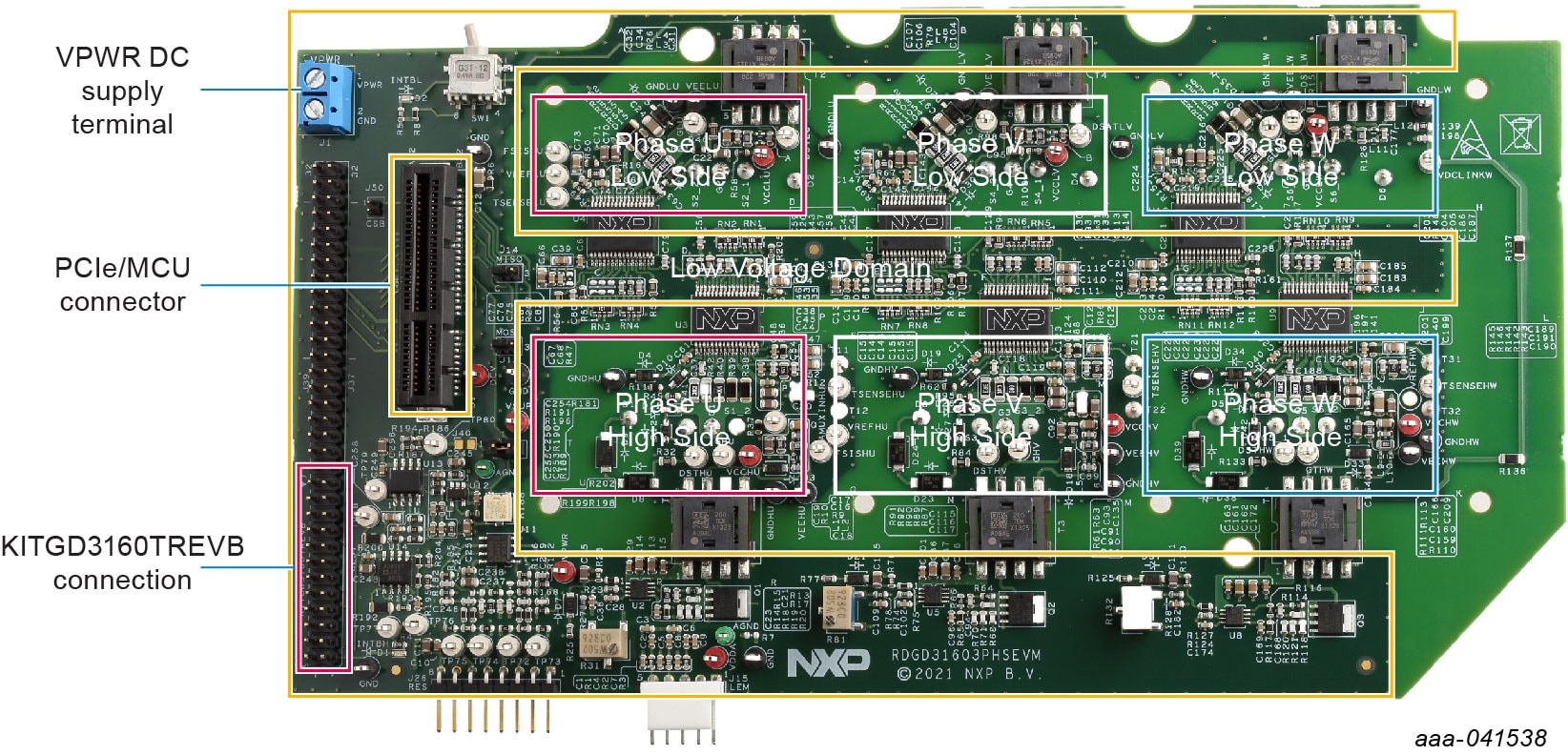Getting Started with the RDGD31603PHSEVM Half-Bridge Evaluation Board
Contents of this document
-
Out of the Box
-
Get Hardware
-
Install Software
-
Configure Hardware
Sign in to save your progress. Don't have an account? Create one.

Purchase your RDGD31603PHSEVM
1. Out of the Box
The NXP analog product development boards provide an easy-to-use platform for evaluating NXP products. The boards support a range of analog, mixed-signal and power solutions. They incorporate monolithic integrated circuits and system-in-package devices that use proven high-volume technology. NXP products offer longer battery life, a smaller form factor, reduced component counts, lower cost, and improved performance in powering state-of-the-art systems.
This page will guide you through the process of setting up and using the RDGD31603PHSEVM board.
1.1 Kit Contents and Packing List
The RDGD31603PHSEVM contents include
- Assembled and tested RDGD31603PHSEVM board in an anti-static bag
- 3.3 V to 5.0 V translator board (KITGD3160TREVB) connected to FRDM-KL25Z with Flex GUI software control
- Quick Start Guide
1.2 Additional Hardware
In addition to the kit contents, the following hardware is necessary or beneficial when working with this reference board.
- Microcontroller for SPI communication
- Compatible SiC MOSFET module
- DC link capacitor compatible with SiC (VE-Trac SiC from OnSemi NVXR17S90M2SP or ST SiC) MOSFET module
- HV power supply with protection shield and hearing protection
- Current sensors for monitoring each phase current
- 12 V, 1.0 A DC power supply
- 4-channel oscilloscope with appropriate isolated probes
1.3 Windows PC Workstation
This reference design requires a Windows PC workstation. Meeting these minimum specifications should produce great results when working with this evaluation board.
- USB-enabled computer with Windows 8 or Windows 10
1.4 Software
Installing software is necessary to work with this reference design. All listed software is available on the information page at RDGD31603PHSEVM.
- Flex GUI software for using with KITGD3160TREVB MCU/translator board
- S32S Design Studio IDE for power architecture
- Automotive Math and Motor Control Library (AMMCL)
- FreeMaster 2.0 runtime debugging tool
- Motor Control Application Tuning (MCAT)
- Example code, GD3160 Device Driver notes and GD31xx Device Driver Reference
2. Get Hardware
2.1 Board Features
- Capability to perform double pulse and short-circuit tests on Phase U using KITGD3160TREVB and FlexGUI. See Phase U schematics and FlexGUI Pulse tab
- Evaluation board designed for and populated with GD3160 Gate Drivers and protection circuitry
- Capability to connect to Hybrid Drive type SiC specific modules for full three-phase evaluation and development
- Daisy chain SPI communication (three high-side and three low-side gate drivers)
- Variable fly-back VCC power supply with GND reference and -3.9 V VEE supply
- Easy access power, ground, and signal test points
- 2×32 PCIe socket for interfacing MCU control (MPC5775B/E-EVB, MPC5777C-DEVB or MPC57744P)
- Optional connection for DC bus voltage monitoring
- Phase current feedback connections
- Resolver signal connector
2.2 Board Description
The RDGD31603PHSEVM is a fully functional three-phase inverter evaluation board populated with six GD3160 gate drivers with fault management and supporting circuitry. This board supports SPI daisy chain communication for programming and communication with three high-side gate drivers and three low-side gate drivers independently.

2.3 Kinetis KL25Z Freedom Board
The Freedom KL25Z is an ultra-low-cost development platform for Kinetis® L Series KL1x (KL14/15) and KL2x (KL24/25) MCUs built on Arm® Cortex®-M0+ processor.

2.4 3.3 V to 5.0 V Translator Board
KITGD3160TREVB translator enables level shifting of signals from MCU 3.3 V to 5.0 V SPI communication.
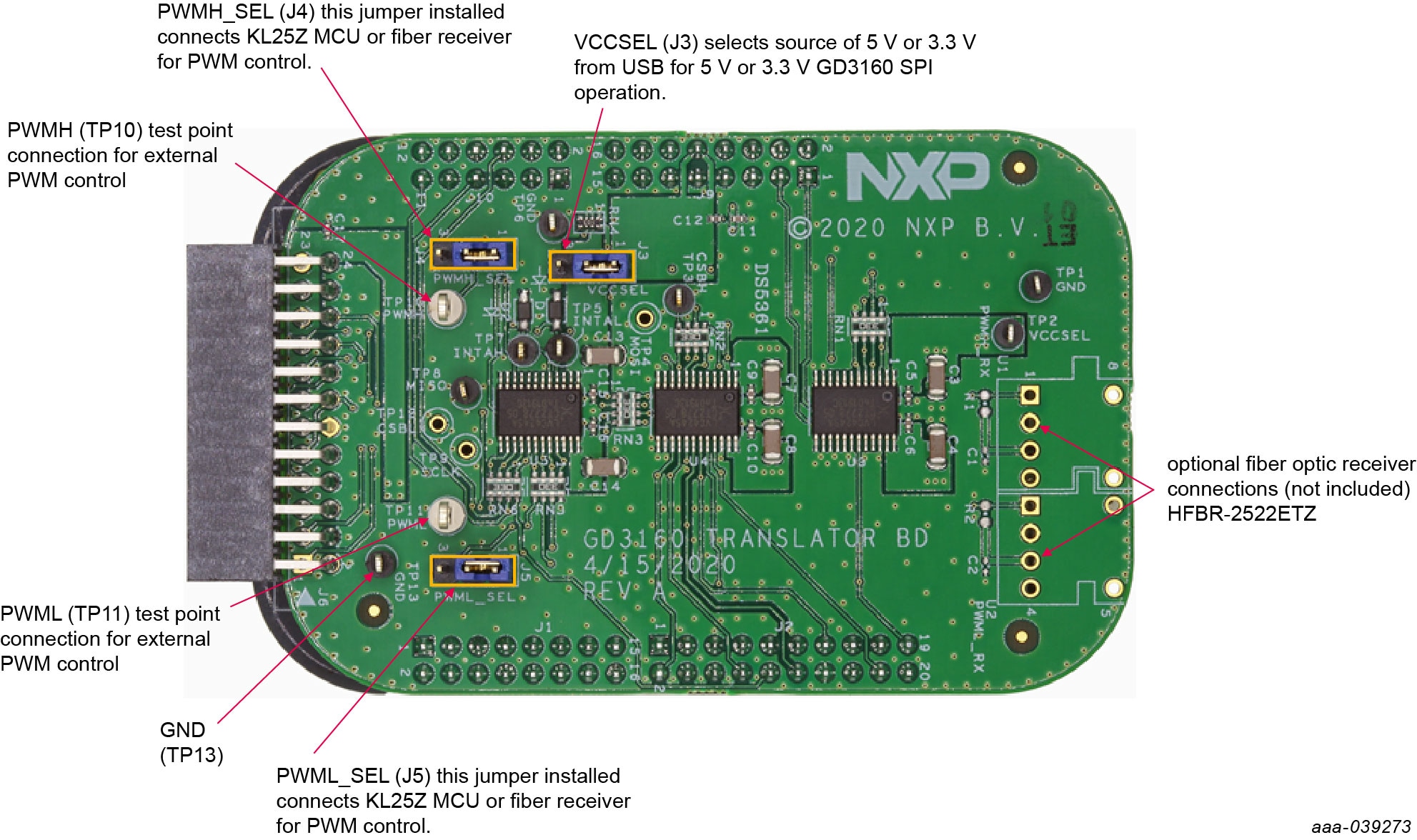
| Jumper | Position | Function |
|---|---|---|
VCCSEL (J3) |
1-2 | selects 5.0 V for 5.0 V compatible gate drive |
| 2-3 | selects 3.3 V for 3.3 V compatible gate drive | |
PWMH_SEL (J4) |
1-2 | selects PWM high-side control from KL25Z MCU |
| 2-3 | selects PWM high-side control from fiber optic receiver inputs | |
PWML_SEL (J5) |
1-2 | selects PWM low-side control from KL25Z MCU |
| 2-3 | selects PWM low-side control from fiber optic receiver inputs |
3. Install Software
Software for RDGD31603PHSEVM is distributed with the FlexGUI tool (available on NXP). Necessary firmware comes pre-installed on the FRDM-KL25Z with the kit.
Even if the user intends to test with other software or PWM, it is recommended to install this software as a backup or to help debugging.
3.1 Install FlexGUI on your Computer
The latest version of FlexGUI supports the GD3100 and GD3160. It is designed to run on any Windows 10 or Windows 8 based operating system. To install the software, do the following:
- Go to FlexGUI and click Download
- When the FlexGUI software page appears, click Download and select the version associated with your PC operating system
- FlexGUI wizard creates a shortcut, an NXP FlexGUI icon appears on the desktop. By default, the FlexGUI executable file is installed at C:\flexgui-app-des-gd31xx.exe Installing the device drivers overwrites any previous FlexGUI installation and replaces it with a current version containing the GD31xx drivers. However, configuration files (.spi) from the previous version remain intact
3.2 Configure the FRDM-KL25Z Microcode
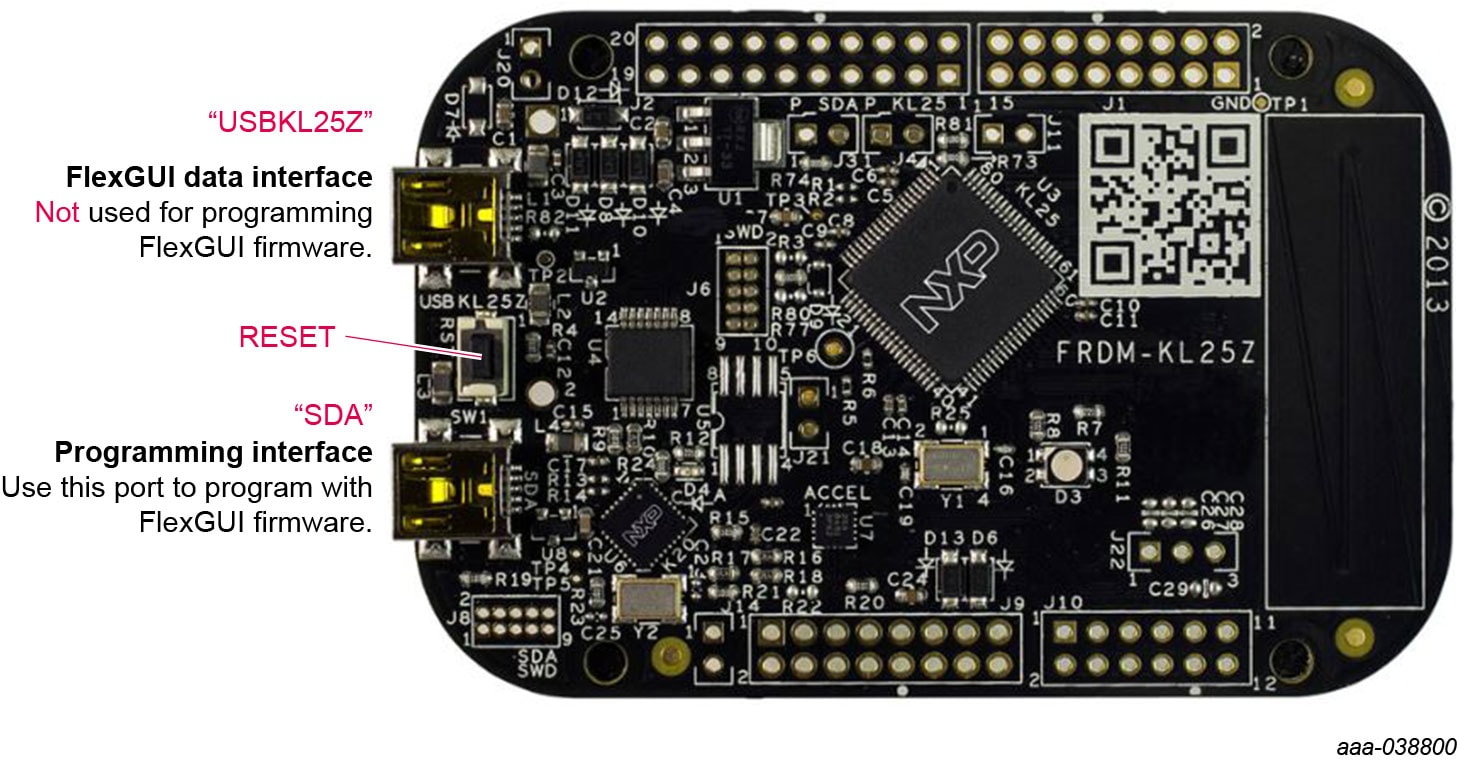
By default, the FRDM-KL25Z delivered with this kit is preprogrammed with the current and most up-to-date firmware available for the kit.
A way to check quickly that the microcode is programmed and the board is functioning properly, is to plug the KL25Z into the computer, open FlexGUI, and verify that the software version at the bottom is 6.4 or later.
If a loss of functionality following a board reset, reprogramming, or a corrupted data issue, the microcode may be rewritten per the following steps:
- To clear the memory and place the board in boot loader mode, hold down the reset button while plugging a USB cable into the OpenSDA USB port
- Verify that the board appears as a BOOTLOADER device and continue with step 3. If the board appears as KL25Z, you may go to step 6
- Download the Firmware Apps .zip archive from the PEmicro OpenSDA webpage. Validate your email address to access the files
- Find the most recent MDS-DEBUG-FRDM-KL25Z_Pemicro_v118.SDA and copy/drag-and-drop into the BOOTLOADER device
- Reboot the board by unplugging and replugging the connection to the OpenSDA port. Verify now that the device appears as a KL25Z device to continue
-
Locate the most recent KL25Z firmware; which is distributed as part of the FlexGUI package
- From the FlexGUI install directory, which is located in the flexgui-app-des-gd31xx\bin0 folder and is named in the form “flexgui-fw-KL25Z_usb_hid_gd31xxC_vx.x.x.bin”
- This .bin file is a product/family-specific configuration file for FRDM-KL25Z containing the pin definitions, SPI/PWM generation code, and pin mapping assignments necessary to interface with the translator board as part of RDGD31603PHSEVM
-
With the KL25Z still plugged through the OpenSDA0 port, copy/drag-and-drop
the .bin file
into the KL25Z device memory. Once done, disconnect the USB and plug into the other USB
port, labeled KL25Z0
- There is no software stored or present on either the driver or translator boards, only on the FRDM-KL25Z MCU board
All uploaded firmware is stored in non-volatile memory until the reset button is hit on the FRDM-KL25Z. There is no need to repeat this process upon every power up, and there is no loss of data associated with a single unplug event.
4. Configure Hardware
4.1 Configure the Hardware
RDGD31603PHSEVM with KITGD3160TREVB attached as shown in the following figure utilizing Windows based PC and FlexGUI software.
Suggested equipment needed for test:
- Rogowski coil high-current probe
- High-voltage differential voltage probe
- High sample rate digital oscilloscope with probes
- DC link capacitor compatible with HybridPACK Drive module
- IGBT or SiC MOSFET HybridPACK Drive module
- Windows based PC
- High-voltage DC power supply for DC link voltage
-
Low-voltage DC power supply for VSUP
- +12 V DC gate drive board low-voltage domain
- Voltmeter for monitoring high-voltage DC link supply
- Load coil for double pulse and short-circuit testing, Phase U only
